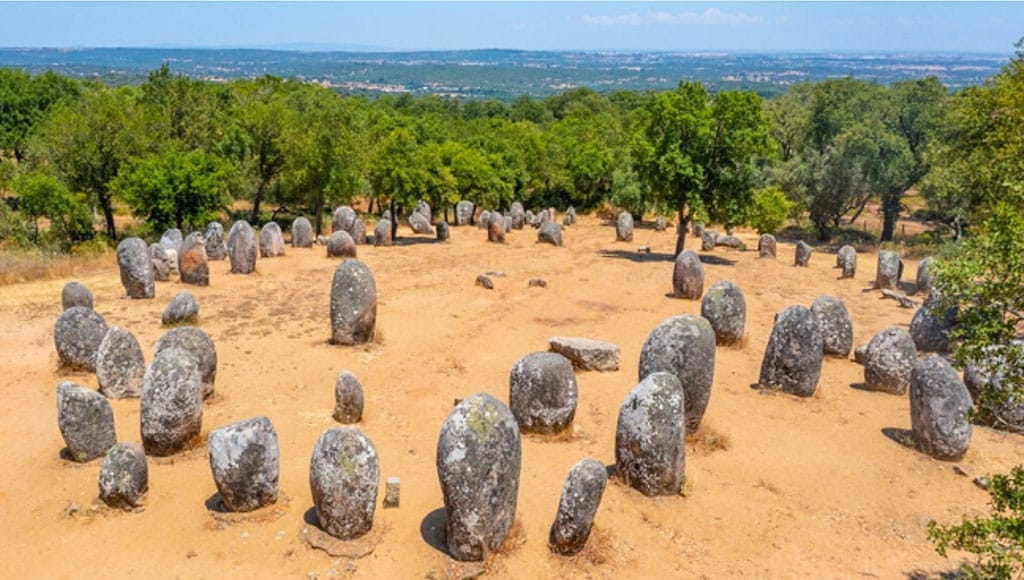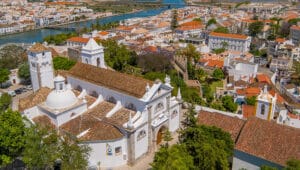This is a revision of an essay which was published in year 2021. Since then, notable advances in archaeological investigative techniques have been made due to improvement in both the machinery employed and the use of digital information aided by artificial intelligence. Additionally, interpretations of the socio-economic evolvement of Celtic people have altered. Corrections thus made are referred to in the Addenda of Chapter 4 (still to be published).
The years 400K to 5K BCE
Migrants of the Homo Heidelbergensis species first entered Western Europe around 400,000 years ago and some wisely chose to relocate to a land of plenty now known as the Tomar region of Central Portugal. There they found a vacant property in the form of the Aroeira cave complex through which ran the Almonda stream to provide fresh water and sanitation while the vicinity was well forested with plentiful fuel and food.
When this labyrinth of passages and caverns was excavated in year 2002, much evidence was found of the former occupation in the form of stone tools, detritus and broken animal bones, but it was not until 2017 that a complete skull was discovered, enabling an accurate composition of facial features such as a low brow, jutting jaw and deep-set eyes.
Just how these hominoids survived and evolved over so many years is unknown, but what is certain is that Neanderthals were present in another nearby warren when the first modern humans migrated from Africa some 40,000 years ago and decided that this cavern, known as the Lapa do Picareiro, would make an ideal new home.
From evidence uncovered during archaeological excavations from 1994 to 2018, it is surmised that the Neanderthals and Homo Sapiens first conflicted and then lived fairly harmoniously for 3,000 years even to the extent of cohabitation.
But what seems more likely is that the occupation fluctuated between the two groups until finally Homo Sapiens dominated and the Neanderthals moved elsewhere to become later extinct.
Before this happened, inter-breeding took place so that the genetic characteristics were carried forward to the humans of today. Evidence of this was found in 1998 by archaeologists working in the limestone Lapedo canyon situated some 15km from Leiria where a rock shelter named Lagar Velho was found to have been used as a burial chamber. Among the remains was the almost intact skeleton of a five-year-old Cro-Magnon child, the cranium of which displayed characteristics of both races and could be dated to about 24,000 years past.

It seems to be an accepted assumption that Homo Sapiens expanded considerably in numbers after the first arrival and formed various tribal settlements along the Atlantic coast and then followed the courses of rivers rising from the north-east of Iberia. At the same time, pockets of Neanderthals probably survived in the less populous locations.
The extraordinary outdoor ensemble of 5,000 Paleolithic rock art drawings in the valley of the river Coa in north-east Portugal bears witness to the economic, social and spiritual life of the tribes which occupied this territory for more than three millennia.
Their creation probably started around 20,000 BCE and subjects are predominantly animalist featuring horses, deer, bison and some creatures such as the woolly rhinoceros which are now extinct.
This first manifestation of human symbolic creation reflects a culture which was moving away from a nomadic hunter/gatherer existence towards the establishment of communities with permanent abodes where the first attempts at domestication of animals and agriculture were made.
If the Coa complex merits the UNESCO award as a World Heritage site, then also must be included the amazing examples of megalith building, in the form of dolmen and menhirs, which are distributed from north to south along the Atlantic seaboard but with especially fine examples present in the Central Alentejo and Western Algarve.
Current data indicates that the single standing stones (menhirs) are among the oldest in the Paleolithic history of Western Europe, but the chambered tombs and other roofed structures (dolmen) appear to be of more recent construction.
Much of this monumental work is in locations isolated from urban life, so the obviously intelligent engineering which enabled their construction can be fully observed although some have unfortunately been destroyed for use as quarries and by the spread of graffiti.
Although the usual debris of bones, broken ceramics and flint tools/arrow heads can be found in their vicinity, there is very little anthropomorphic detail to indicate the physical attributes and social structure of the various tribes.
That is why the recent discoveries at the Alentejo site of Perdigões are so interesting. Here an aerial survey revealed 15 circular pits, the excavation of which produced a mass of broken ceramics, stone chippings and, surprisingly, carvings in ivory which included 20 representations of humans or their deities.
The detail is astonishing: slender, carefully profiled bodies, high foreheads, straight noses, facial tattoos and large rounded eye sockets which probably held semi-precious stones. Comparison to sci-fi representations of aliens cannot be avoided!
Even more remarkable is that the ivory has been attributed to the African elephant, which indicates that the beasts or only their tusks were imported through established trading routes thus confirming the establishment of commerce.
Further light on the nature of our Neolithic ancestors was shed by the exhibition “Ídolos – Olhares Milenares” in year 2021 at the Museu Nacional de Arqueologia in Lisbon where stone fragments and iron tools found in Iberian tumuli were loaned by both Spanish and Portuguese entities.
Chapter 2 published next week.
|| features@portugalresident.com
Roberto Cavaleiro has been resident in Portugal since 1989 and possesses dual Portuguese/British nationality. Now in his 10th decade, he devotes much of his senility to the composition of essays, poems and commentaries on a diversity of Portuguese subjects.
























